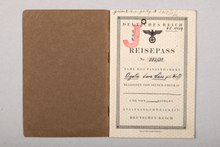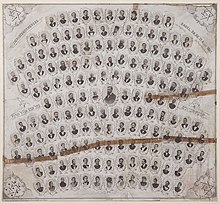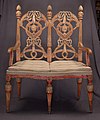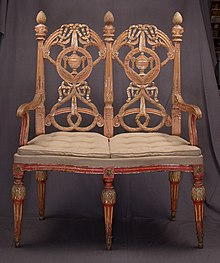User:LGLou/sandbox
Practice page
[edit]
This is an experiment. Soon I will hopefully be a published wikipedian author. Yay! And now I am going to quote for the sake of quoting, and say "rage against the dying of the light!"[1]
And now for uploading images, for that is the sole purpose of my existence. Art is indeed the meaning of life.
-
experiment with gallery possibilities
And now for something completely different.
Working on references is also important. Can I link the name, but you only see the title?[2]
5. Sabbatampel in Basel
[edit]blahblahblaskdjflkdjsfkdslkjlasl and here it is very serious as you can see
oh deary me! and now I want to link a particular image to this particular text passage, but I am not sure that is possible... let me see.
-
Menorah
-
candles
-
and this is it in Brandenburg
-
this object is exhibited in the Jewish Museum of Switzerland
Torah mantle
[edit]
This Torah mantle was found in the storage room of the synagogue in Endingen (AG) in 1967. The material was a French 18th century silk originally used as a ladies’ dress, perhaps even a wedding gown. It was repurposed as a Torah mantle, a controversial yet fairly common practice before the 20th century.
Passport with J-Stamp
[edit]
On the 30th of December 1938, Agatha Süss’s German passport was stamped with a “J” to mark her as Jewish. Because her daughter married a Swiss man, the 63-year old successfully procured a visa for Switzerland and was able to take up residence with her son-in-law in Basel, thus escaping the Holocaust.
Lichtbild zum ersten Zionistencongress
[edit]
The collotype process of the mid 19th century made it relatively easy to produce hundreds of photographs at a time. This collotype shows the 162 participants of the First Zionist Congress, which took place in Basel in 1897. While most participants were men, some women took part as well. Their photos are on the bottom row. Women were allowed to participate, but not to vote.
Collection
[edit]The first objects shown in the Jewish Museum’s exhibition were Judaica collected by the Swiss Museum of Folklore (now Museum der Kulturen Basel). The museum’s collection expanded after 1966 to include objects from Basel and the Upper Rhine, from the two Surbtal villages Endingen and Lengnau as well as from the remainder of Switzerland and Europe.
Highlights of the museum’s collection include silver ceremonial objects, richly embroidered textiles from the 17th to the 20th centuries and documents from the cultural history of the Jews in Switzerland. The monumental medieval gravestones and the Basel Hebrew prints are important historical testimonies. Documents on the Basel Zionist Congresses and original letters from Theodor Herzl, the author of "Der Judenstaat", show Basel as a city that made world politics. The museum is also collecting contemporary objects — Judaica, art, and objects from everyday life.

J-stamped Passport
[edit]On the 30th of December 1938, Agatha Süss’s German passport was stamped with a “J” to mark her as Jewish. Because her daughter married a Swiss man, the 63-year old successfully procured a visa for Switzerland and was able to take up residence with her son-in-law in Basel, thus escaping the Holocaust.
Circumcision Bench
[edit]This circumcision bench was carved in 1791 and entered the museum’s collection in 1973. It is inscribed with words from the First Book of Moses: “And you shall be circumcised in the flesh of your foreskin, and it shall be the sign of the covenant between Me and you. And every male among you who is eight days old shall be circumcised throughout your generations (Genesis 17:11).”

Torah Mantle
[edit]This Torah mantle was found in the storage room of the synagogue in Endingen (AG) in 1967. The material was a French 18th century silk originally used as a ladies’ dress, perhaps even a wedding gown. It was repurposed as a Torah mantle, a controversial yet fairly common practice before the 20th century.
Collotype from the First Zionist Congress
[edit]The collotype process of the mid 19th century made it relatively easy to produce hundreds of photographs at a time. This collotype shows the 162 participants of the First Zionist Congress, which took place in Basel in 1897. While most participants were men, some women took part as well. Their photos are on the bottom row. Women were allowed to participate, but not to vote.
Collection
[edit]The first objects shown in the Jewish Museum’s exhibition were Judaica collected by the Swiss Museum of Folklore (now Museum der Kulturen Basel). The museum’s collection expanded after 1966 to include objects from Basel and the Upper Rhine, from the two Surbtal villages Endingen and Lengnau as well as from the remainder of Switzerland and Europe.
Highlights of the museum’s collection include silver ceremonial objects, richly embroidered textiles from the 17th to the 20th centuries and documents from the cultural history of the Jews in Switzerland. The monumental medieval gravestones and the Basel Hebrew prints are important historical testimonies. Documents on the Basel Zionist Congresses and original letters from Theodor Herzl, the author of "Der Judenstaat", show Basel as a city that made world politics. The museum is also collecting contemporary objects — Judaica, art, and objects from everyday life.

J-stamped Passport
[edit]On the 30th of December 1938, Agatha Süss’s German passport was stamped with a “J” to mark her as Jewish.
Because her daughter married a Swiss man, the 63-year old successfully procured a visa for Switzerland and was able to take up residence with her son-in-law in Basel, thus escaping the Holocaust.

Circumcision Bench
[edit]This circumcision bench was carved in 1791 and entered the museum’s collection in 1973.
It is inscribed with words from the First Book of Moses:
“And you shall be circumcised in the flesh of your foreskin, and it shall be the sign of the covenant between Me and you. And every male among you who is eight days old shall be circumcised throughout your generations
(Genesis 17:11).”

Torah Mantle
[edit]This Torah mantle was found in the storage room of the synagogue in Endingen (AG) in 1967.
The material was a French 18th century silk originally used as a ladies’ dress, perhaps even a wedding gown.
It was repurposed as a Torah mantle, a controversial yet fairly common practice before the 20th century.
Collection
[edit]The first objects shown in the Jewish Museum’s exhibition were Judaica collected by the Swiss Museum of Folklore (now Museum der Kulturen Basel). The museum’s collection expanded after 1966 to include objects from Basel and the Upper Rhine, from the two Surbtal villages Endingen and Lengnau as well as from the remainder of Switzerland and Europe.
Highlights of the museum’s collection include silver ceremonial objects, richly embroidered textiles from the 17th to the 20th centuries and documents from the cultural history of the Jews in Switzerland. The monumental medieval gravestones and the Basel Hebrew prints are important historical testimonies. Documents on the Basel Zionist Congresses and original letters from Theodor Herzl, the author of "Der Judenstaat", show Basel as a city that made world politics. The museum is also collecting contemporary objects — Judaica, art, and objects from everyday life.
J-stamped Passport
[edit]On the 30th of December 1938, Agatha Süss’s German passport was stamped with a “J” to mark her as Jewish. Because her daughter married a Swiss man, the 63-year old successfully procured a visa for Switzerland and was able to take up residence with her son-in-law in Basel, thus escaping the Holocaust.
Circumcision Bench
[edit]This circumcision bench was carved in 1791 and entered the museum’s collection in 1973. It is inscribed with words from the First Book of Moses: “And you shall be circumcised in the flesh of your foreskin, and it shall be the sign of the covenant between Me and you. And every male among you who is eight days old shall be circumcised throughout your generations (Genesis 17:11).”
Torah Mantle
[edit]This Torah mantle was found in the storage room of the synagogue in Endingen (AG) in 1967. The material was a French 18th century silk originally used as a ladies’ dress, perhaps even a wedding gown. It was repurposed as a Torah mantle, a controversial yet fairly common practice before the 20th century.
- ^ https://poets.org/poem/do-not-go-gentle-good-night
- ^ Horncastle, Julia (2008-09-01). "Queer Bisexuality: Perceptions of Bisexual Existence, Distinctions, and Challenges". Journal of Bisexuality. 8 (1–2): 25–49. doi:10.1080/15299710802142192. ISSN 1529-9716.









